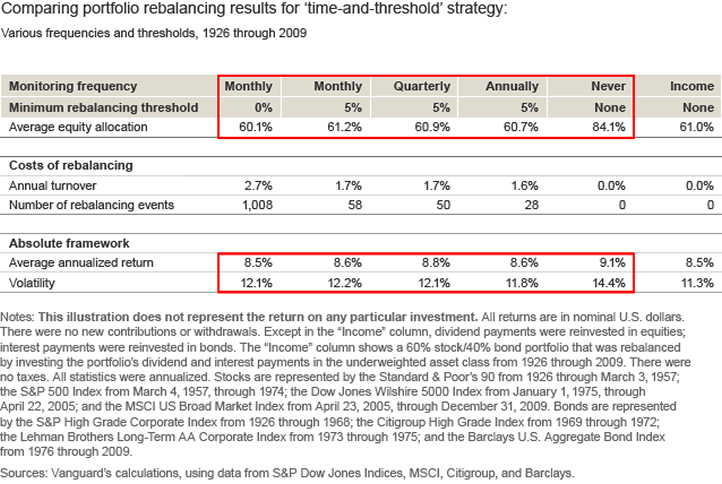An important tenet of portfolio construction is rebalancing your portfolio to maintain your desired risk profile and also provide the best risk-adjusted returns. The next question is usually – Okay, so how often do I rebalance? Well, this Vanguard article targeted at financial advisors answers that question (found via Abnormal Returns).
Longer answer:
Our 2010 study looked at the performance of portfolios that used rebalancing strategies based on various time intervals, allocation thresholds, and combinations of both. The time-based portfolios were rebalanced monthly, quarterly, or annually, while the threshold categories were rebalanced when allocations deviated by a predetermined minimum (in this case 1%, 5%, or 10%) from their target allocations. The “time-and-threshold” strategy combined periodic monitoring with predetermined minimum rebalancing thresholds. […] We found that no one approach produced significantly superior results over another. However, all strategies resulted in more favorable risk-adjusted portfolio returns when compared with returns for portfolios that were never rebalanced.

Short answer: It doesn’t matter, as long as you do it regularly and without emotion. Rebalancing every month was no better than rebalancing just once a year.
Personally, I try to rebalance whenever I make my monthly share purchases by buying underweight asset classes, but I will only sell and create a taxable event once a year if things are really out of whack. The more common problem is that you are afraid to rebalance because that usually means buying whatever has been getting crushed and selling what has been rising. If you haven’t done it recently, that probably involves selling some stocks and buying some bonds. Like the shoe company says, just do it!
 The Best Credit Card Bonus Offers – 2025
The Best Credit Card Bonus Offers – 2025 Big List of Free Stocks from Brokerage Apps
Big List of Free Stocks from Brokerage Apps Best Interest Rates on Cash - 2025
Best Interest Rates on Cash - 2025 Free Credit Scores x 3 + Free Credit Monitoring
Free Credit Scores x 3 + Free Credit Monitoring Best No Fee 0% APR Balance Transfer Offers
Best No Fee 0% APR Balance Transfer Offers Little-Known Cellular Data Plans That Can Save Big Money
Little-Known Cellular Data Plans That Can Save Big Money How To Haggle Your Cable or Direct TV Bill
How To Haggle Your Cable or Direct TV Bill Big List of Free Consumer Data Reports (Credit, Rent, Work)
Big List of Free Consumer Data Reports (Credit, Rent, Work)
Quarterly rebalancing was 0.2% better than monthly or annual. Thats nothing to sneeze at over 30 years.
But is that number statistically significant? If monthly is worse than quarterly, it may very well be chance that made quarterly rebalancing better. It’s not like the more often you do it, the better.
I don’t know really but I’d trust that Vanguards analysis here wouldn’t have a high margin of error. They are just taking past performance and running the numbers. I do agree with the main point that the frequency of rebalancing does not seem to make much difference.
I’m sure their historical numbers are fine, it is more about whether the next 30 years will mimic the last 30 years down that closely. I wouldn’t create more taxable events to chase that 0.2% unless I really like rebalancing every quarter anyway.
Speaking of “statistically significant”, how much better is 12% volatility than 14% from the “Never” column? Don’t know exactly what those percentages mean, but giving up from 0.3-0.6% annual return to drop volatility that little doesn’t seem like such a great deal.
Interesting study. I tend to only rebalance when my portfolio strays by more than 5% of my overall target allocation. This is usually only once or twice a year.
The financial industry has been heavily promoting rebalancing for a long time. I feel that they say this for a value add of their services. I do think rebalancing is important but not as often as recommended. If I do any rebalancing, its in my tax deferred accounts, very rarely in taxable accounts. (Both accounts have same type funds)
I just do the automatic quarterly rebalancing feature available with Nationwide, with whom i have my 401k with. I used to do it manually but it was not much better than the automatic route. It saves me the headache. Once I get my savings back up, I might do active investing and then, i will think about manual rebalancing.
Great post!